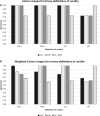Defining rurality: an evaluation of rural definitions and the impact on survival estimates
- PMID: 36762829
- PMCID: PMC10165490
- DOI: 10.1093/jnci/djad031
Defining rurality: an evaluation of rural definitions and the impact on survival estimates
Abstract
Background: Patients with cancer living in rural areas have inferior cancer outcomes; however, studies examining this association use varying definitions of "rural," complicating comparisons and limiting the utility of the results for policy makers and future researchers.
Methods: Surveillance, Epidemiology, and End Results data (2000-2016) were used to assess risk of cancer mortality and mortality from any cause across 4 definitions of rurality: Urban Influence codes (UIC), National Center for Health Statistics (NCHS), Rural-Urban continuum codes (RUCC), and Index of Relative Rurality. Binary (urban vs rural) and ternary (urban, micropolitan, rural) definitions were evaluated. Multivariable parametric survival models estimated hazards of mortality overall and among 3 cancer groupings: screening related, obesity related, and tobacco related. Definition agreement was also assessed.
Results: Overall, 3 788 273 patients with an incident cancer representing 605 counties were identified. There was little discordance between binary definitions of rural vs urban and moderate agreement at the 3 levels. Adjusted models using binary definitions revealed 15% to 17% greater hazard of cancer mortality in rural compared with urban. At the 3 levels when comparing rural with metropolitan, RUCC and NCHS saw similarly increased hazard ratios; however, Index of Relative Rurality did not. Screening-related cancers saw the highest hazards of mortality and the largest divergence between definitions. Obesity-related and tobacco-related cancers saw similarly increased hazards of mortality at the binary and ternary levels.
Conclusions: Hazard of death is similar across binary definitions; however, this differed when categorized as ternary or continuous, especially among screening-related cancers. Results suggest that study purpose should direct choice of definitions and categorization.
© The Author(s) 2023. Published by Oxford University Press. All rights reserved. For permissions, please email: journals.permissions@oup.com.
Conflict of interest statement
None.
Figures



Similar articles
-
Urban-rural differences in cancer mortality: Operationalizing rurality.J Rural Health. 2024 Mar;40(2):268-271. doi: 10.1111/jrh.12792. Epub 2023 Aug 29. J Rural Health. 2024. PMID: 37644650 Free PMC article.
-
Cancer disparities in the context of rurality: risk factors and screening across various U.S. rural classification codes.Cancer Causes Control. 2022 Aug;33(8):1095-1105. doi: 10.1007/s10552-022-01599-2. Epub 2022 Jun 30. Cancer Causes Control. 2022. PMID: 35773504 Free PMC article.
-
Potentially Excess Deaths from the Five Leading Causes of Death in Metropolitan and Nonmetropolitan Counties - United States, 2010-2017.MMWR Surveill Summ. 2019 Nov 8;68(10):1-11. doi: 10.15585/mmwr.ss6810a1. MMWR Surveill Summ. 2019. PMID: 31697657
-
Federal definitions of rurality and the impact on nursing research.Res Nurs Health. 2007 Apr;30(2):175-84. doi: 10.1002/nur.20194. Res Nurs Health. 2007. PMID: 17380518 Review.
-
Measuring rurality in health services research: a scoping review.BMC Health Serv Res. 2022 Nov 12;22(1):1340. doi: 10.1186/s12913-022-08678-9. BMC Health Serv Res. 2022. PMID: 36369057 Free PMC article.
Cited by
-
Exploring rural-urban differences in the receipt of nonelective cancer-specific gastrointestinal surgery using a multilevel mixed-effects approach.J Gastrointest Surg. 2025 Jan;29(1):101858. doi: 10.1016/j.gassur.2024.10.013. Epub 2024 Oct 16. J Gastrointest Surg. 2025. PMID: 39419275
-
Estimating the Impact of Rurality in Disparities in Cancer Mortality.JCO Oncol Pract. 2024 Jul;20(7):993-1002. doi: 10.1200/OP.23.00626. Epub 2024 Apr 1. JCO Oncol Pract. 2024. PMID: 38560814 Free PMC article.
-
An essential goal within reach: attaining diversity, equity, and inclusion for the Journal of the National Cancer Institute journals.JNCI Cancer Spectr. 2023 Aug 31;7(5):pkad063. doi: 10.1093/jncics/pkad063. JNCI Cancer Spectr. 2023. PMID: 37806772 Free PMC article. No abstract available.
-
Urban-rural differences in cancer mortality: Operationalizing rurality.J Rural Health. 2024 Mar;40(2):268-271. doi: 10.1111/jrh.12792. Epub 2023 Aug 29. J Rural Health. 2024. PMID: 37644650 Free PMC article.
-
Comparison of US Oncologist Rurality by Practice Setting and Patients Served.JAMA Netw Open. 2024 Jan 2;7(1):e2350504. doi: 10.1001/jamanetworkopen.2023.50504. JAMA Netw Open. 2024. PMID: 38180759 Free PMC article.
References
-
- Han X, Yabroff KR, Ward E, Brawley OW, Jemal A.. Comparison of insurance status and diagnosis stage among patients with newly diagnosed cancer before vs after implementation of the patient protection and affordable care act. JAMA Oncol. 2018;4(12):1713-1720. doi:10.1001/jamaoncol.2018.3467. - DOI - PMC - PubMed
Publication types
MeSH terms
Grants and funding
LinkOut - more resources
Full Text Sources
Medical

